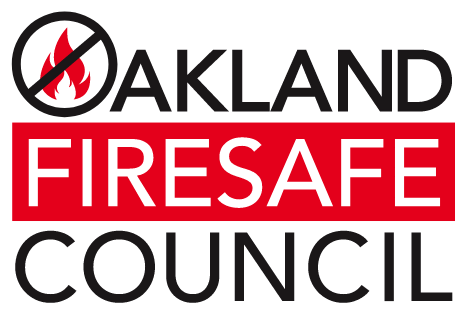The Oakland Firesafe Council, along with more than 20 other neighborhood associations and local residents believes the current draft 10-year Vegetation Management Plan for Oakland and the Draft Environmental Impact Review (EIR) leads to a false sense of security. The Plan is based on a snapshot of conditions in 2018 and does not take into account the worsening fire behavior, stronger winds leading to longer flame lengths and burning embers flying further, and a growing lethal pathogen that is decimating acacias, Bay laurels and eucalyptus along the East Bay Ridge. Furthermore, it does not include anything about restoring removed vegetation with less flammable native trees and plants. By being so focused on doing what the City has done for Annual Vegetation Management for the past 15 years, the plan overlooks addressing the real risks we now face with a plan that is environmentally, fiscally and politically sustainable.
The current proposed Plan and Draft EIR is purposefully based on the past 15 years of Oakland’s experience with annual vegetation which addressed roadside clearance and defensible space around structures. It is modeled on 20 mph winds, when Oakland and the East Bay is experience more frequent Public Safety Power Shutoffs (PSPS) with winds at 60 mph or higher. (Even during the 1991 Tunnel Fire winds were clocked at 60 mph.) Stronger winds lead to longer flame lengths and send embers flying more than a half mile. It doesn’t address the risk of lightning strikes that create crown fires like the ones that devastated California this past summer and fall. Consequently, using a model that only requires 300 feet of defensible space from a ridge line, 35-foot roadside clearance (UC Berkeley’s standard is 100 feet to remove trees that might fall and block evacuation routes), 150 feet around structures and 10 feet around the perimeter of city property is insufficient. The plan calls for thinning of trees and annual goat grazing to keep ground fuels in check. But goats don’t eat the slash that peels off of the remaining eucalyptus, nor do they eat the fallen limbs from our aging Monterey pines and other trees that were planted in our hills more than 100 years ago. The Plan and Draft EIR offer no strategies to address this.
Dimond Canyon is a case in point. The canyon is full of overgrown vegetation, and is particularly hard hit by the unknown pathogen that is killing acacias, Bay laurel and eucalyptus. Yet the current Draft EIR only calls for 35 feet of roadside clearance along Park Blvd. If an ember from a fire in Joaquin Miller Park or along Redwood ridge spread a fire down to Dimond Canyon, not only would the homes along Park Blvd. and Oakmore be at risk, but so would the residents of the Fruitvale below Dimond Park. This isn’t just hypothetical; a fire that started on Redwood Ridge swept through Joaquin Miller Park and Dimond Park in 1933.

Adding a fifth PREFERRED alternative that addresses these changes is environmentally, fiscally and politically sustainable.
Alternative 5 is basically the proposed Vegetation Management Plan plus a phased removal of hazardous trees and replacement with native trees and plants in the eucalyptus/pine/cypress habitat. Under Alternative 5, 359 acres of eucalyptus/pine/cypress would be removed and restored, as opposed to 214 acres treated through thinning as proposed in the Vegetation Management Plan. This is necessary because the Plan does not propose any ongoing maintenance to deal with the slash and other debris from the treated areas, other than goat grazing. Goats don’t eat dead limbs or tree slash, and there is no plan for raking this up year after year. When, pine, cypress and eucalyptus burn, they generate embers that jump the gap we create with annual maintenance under the current standards. The plan needs to address these using a 3R approach: Phased Removal of hazardous trees, Restore native habitat to replace removed vegetation; Re-establish native biodiversity to better withstand wildfires.


